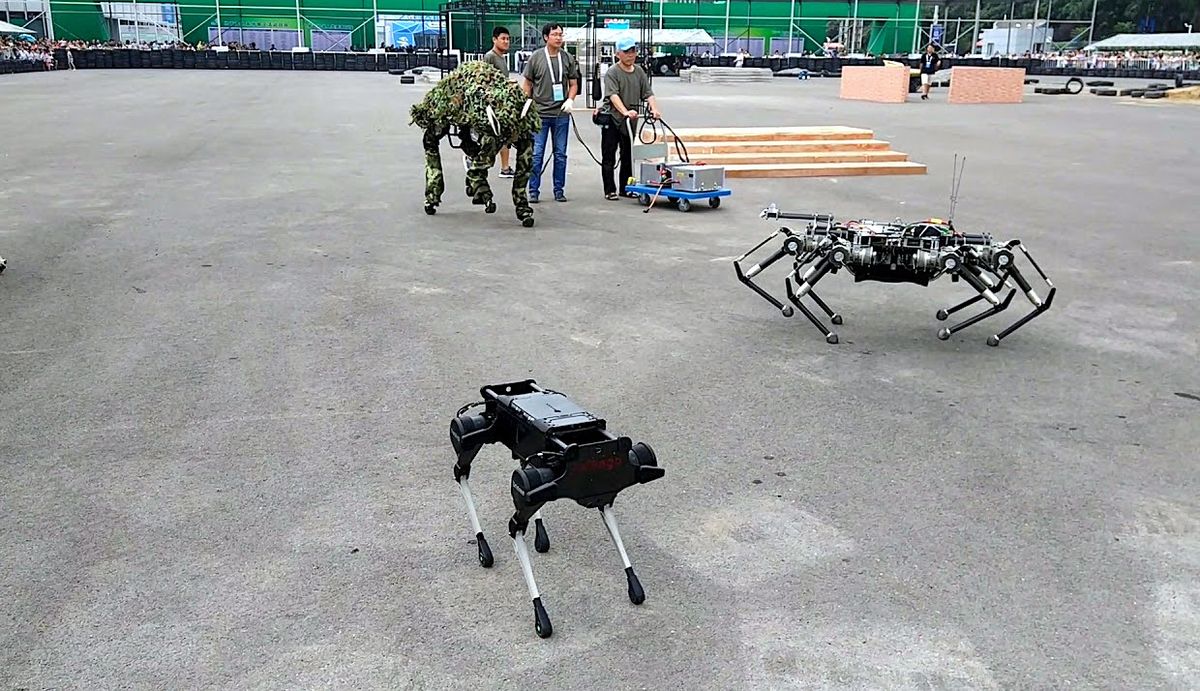Video Friday is your weekly selection of awesome robotics videos, collected by your Automaton bloggers. We’ll also be posting a weekly calendar of upcoming robotics events for the next few months; here’s what we have so far (send us your events!):
ISR 2018 – August 24-27, 2018 – Shenyang, China
BioRob 2018 – August 26-29, 2018 – University of Twente, Netherlands
RO-MAN 2018 – August 27-30, 2018 – Nanjing, China
ELROB 2018 – September 24-28, 2018 – Mons, Belgium
ARSO 2018 – September 27-29, 2018 – Genoa, Italy
ROSCon 2018 – September 29-30, 2018 – Madrid, Spain
IROS 2018 – October 1-5, 2018 – Madrid, Spain
Let us know if you have suggestions for next week, and enjoy today’s videos.
Some of China’s most advanced legged robots were prancing around the World Robot Conference in Beijing, including a small quadruped called Laikago from Unitree Robotics that we wrote about last year and a big quadruped from the China North Vehicle Research Institute. They all look very Boston Dynamics-y, except for the one that has six legs, from Shanghai Jiao Tong University.
I suppose you could make the argument that a hexapod is more stable since it can maintain three points of ground contact while moving, but you can do that with a quadruped too, if you really want to.
[ WRC 2018 ]
DJI has set the standard for drones over the past several years, first with its distinctive white Phantoms, and more recently with the portable workhorse Mavic Pro. Yesterday, DJI introduced the new Mavic Pro 2, with better cameras, more sensors, and more autonomy.
And here are some samples of the kind of drone footage that you’ll probably never, ever get:
[ DJI ]
Takayuki Todo’s SEER (Simulative Emotional Expression Robot) can now accurately mimic facial expressions in real time:
[ SEER ]
In Penn’s Scalable Autonomous Robots Lab, three researchers watch from a cluster of computer monitors as small black boats navigate through water in a large indoor pool, seemingly battling against artificially produced currents. But the toy-sized, robotic ships aren’t fighting the currents; they’re actually using them to move around.
They’re part of an autonomous fleet being used by M. Ani Hsieh and a team in her lab. Their goal is to enable robots to perform useful tasks across the ocean, fueled by the power of the water’s currents, with the ability to stay in the ocean beyond the lengths of time any manned vehicle could without extensive equipment and fuel.
[ Penn ]
If you have an Aibo that you’re emotionally attached to, this video from the Aibo factory is probably not something you should watch.
[ Nikkei ]
Of course you should not attempt that moving car dance challenge thing yourself. Because your robot dances to Drake much better than you.
[ CMU AirLab ]
Thanks Sebastian!
PlutoX is a hackable drone that’s on Indiegogo right now: It looks pretty good, and doesn’t cost all that much at all.
We should note, of course, that “easy to code,” “crash resistant,” and “affordable” are all terms that can be somewhat subjective. Of these, I have the most unambiguous faith in “affordable,” since $169 for the tinker kit seems cheap. We should also note that crowdsourced drone projects have a mixed history, and many of them didn’t, er, take off.
[ Indiegogo ]
Thanks Apurva!
A quick update from NASA on its Mars robots:
Not mentioned is Opportunity, who (we hope) will soon call home after surviving the dust storm.
[ NASA ]
In August 2018, Drone Delivery Canada flew Beyond Visual Line of Sight (BVLOS) missions in Alma Quebec Canada. The test flights in Alma, Quebec were the first phase of DDC’s Remote Communities Project.
Looks like Relay has found a job across the pond. No, not that pond, the other pond.
I don’t know what truffle chips are, but I need some.
[ Savioke ] via [ Robotstart ]
Huge systems of rotating water masses - called gyres - form in oceans and large lakes. Two EPFL laboratories, working with the University of California, Davis, are using an underwater glider to explore one such gyre in Lake Geneva and learn more about how it affects the three-dimensional structure of the aquatic ecosystem.
[ EPFL ]
The follower demo, a super simple behavior that’s very common on TurtleBot-type robots, is still one of the most compelling ways of getting a robot to autonomously interact with people.
[ NXROBO ]
Mouser and Grant Imahara tour Cyberdyne in Tokyo to see how they are using technology to return personal mobility– and hope– to patients.
[ Generation Robot ]
If you’re a fan of DotA, you’ll appreciate this strategic analysis of the OpenAI Five Benchmark games. If you’re like me, and you’re pretty sure that "Dota" is an acronym for something but you don’t know what, you might not get quite as much out of it.
[ OpenAI ]
Evan Ackerman is a senior editor at IEEE Spectrum. Since 2007, he has written over 6,000 articles on robotics and technology. He has a degree in Martian geology and is excellent at playing bagpipes.
Erico Guizzo is the Director of Digital Innovation at IEEE Spectrum, and cofounder of the IEEE Robots Guide, an award-winning interactive site about robotics. He oversees the operation, integration, and new feature development for all digital properties and platforms, including the Spectrum website, newsletters, CMS, editorial workflow systems, and analytics and AI tools. An IEEE Member, he is an electrical engineer by training and has a master’s degree in science writing from MIT.



